| So a scratch ruins an
objective?? A surprising revelation gleaned from a chance meeting with an abused optic By Paul James (UK)
|
| So a scratch ruins an
objective?? A surprising revelation gleaned from a chance meeting with an abused optic By Paul James (UK)
|
Though we harbour varying degrees of concern about the importance of the cosmetic condition of an instrument in our possession, our feelings regarding its optical condition are more likely to be unanimous. The natural and understandable assumption is that a scratch, score or other physical blemish on an optical surface degrades the image making capabilities of the instrument. Fortunately, in reality the problem is nearly always a psychological one, because the actual image degrading capabilities of a scratch mark is a function of its surface area with that of the lens. Thus one simple elongated scratch across an objective's face element might only add up to about 0.01% of its total area : A multitude of marks proportionately more so.
The effect of the marking(s) is to simply scatter light away from its intended route along the optical axis, and fortunately this unwanted light is dispersed very effectively over the entire imaging zone and beyond. In reality therefore, a large proportion of the light diffused by one or two scratches doesn't even get near to diluting the image's contrast. Large numbers of very fine scratches resulting from 'industrious' cleaning can cause an observable diminishment of contrast, in a similar way that streaks of oily or greasy films across the glass would, though the latter is capable of seriously degrading a fine image. Immersion oil dabbed sparingly on the face of a x40 objective demonstrates this very effectively and teaches us the necessity of using 'grease' free optical surfaces.
Now the purpose of this article is not to fuel the concerns of perfectionists, but to demonstrate in a rather spectacular way that scratched optical surfaces cause more aberrations in the imagination than in the image. By way of demonstration I shall describe and illustrate in this article the imaging of an objective that has suffered from appalling abuse. I'm not going to elaborate on how this optic's front element became damaged, because I simply do not know.
The optic in question : a Leitz NPL x 40 0.65 na objective came to my possession recently. Cosmetically it was near perfect but its front element's exterior surface was irreparably damaged, though little sign of this abuse could be seen by the unaided eye .
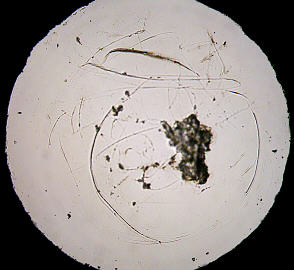 |
The scale of the damage beggars belief as the bright field image shows above. The front element housing was removed and placed on a clear slide for examination in BF and DF. The large dark marking is a shallow crater where a flake of glass has been removed, and smaller pits exist across the glass, as well as deep scoring.
More damage is revealed as this oblique lighting image below clearly shows. Note the incredible spiral scoring?? This image conveys only 15-20 % of the total area of the front element!!
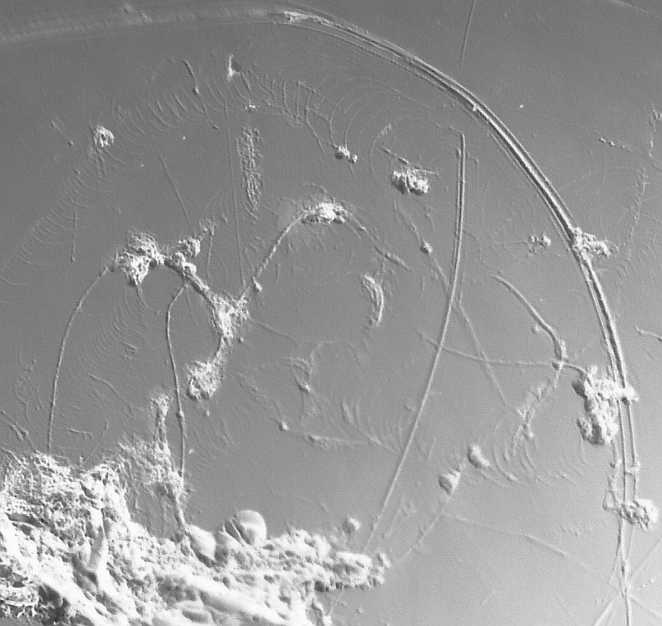 |
Having such a unique opportunity to gauge the effects of a multitude of markings on this objective's front element made me intensely curious about how it would perform. I doubt if many microscopists have seen such a damaged optic as this? The photo's below depict its imagery under different lighting configurations. The results I found astonishing, and I think the reader might too considering the state of the front element. I used a very good example of a x40 Wild achromat for comparison:-
Wild Achromat x40 0.65na (LEFT) and damaged Leitz Achromat x40 0.65na (RIGHT)
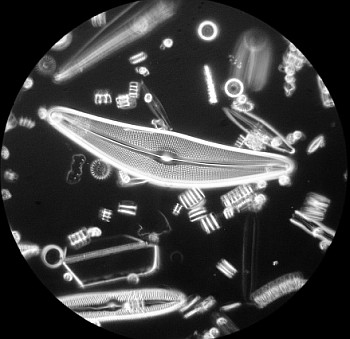 |
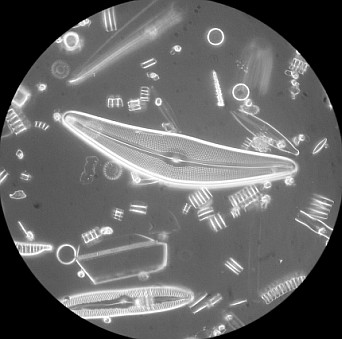 |
| Normal DF image (the most sensitive test) | More contrast and detail here than expected |
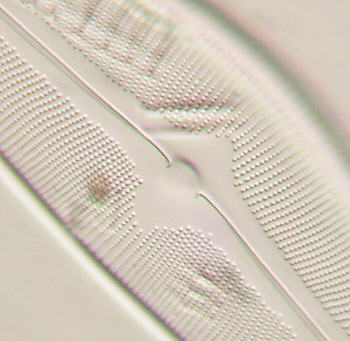 |
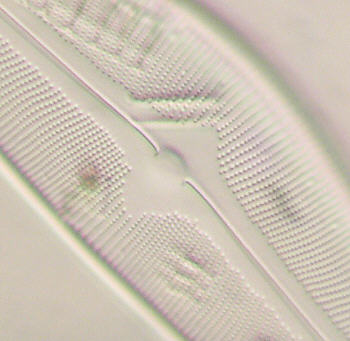 |
| (x1250) BF/Oblique | Very similar but slightly less contrast |
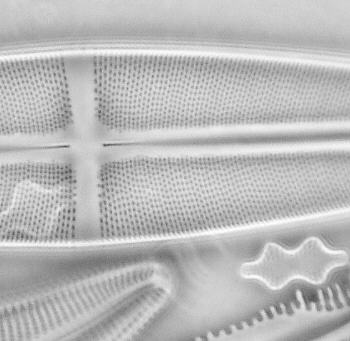 |
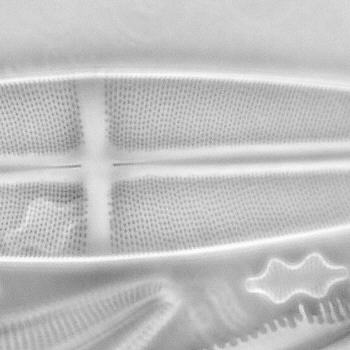 |
(x1250) COL |
Far better than expected |
Brightfield below with 1) Fully open iris 2) 50% iris closure and 3) 95% iris closure. Note silhouetting of damage.
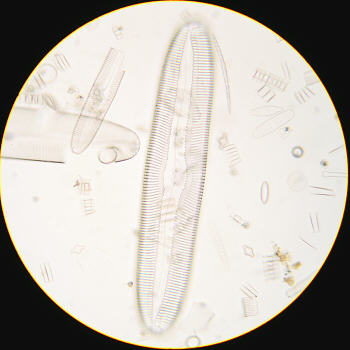 |
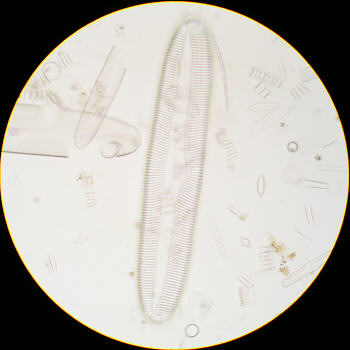 |
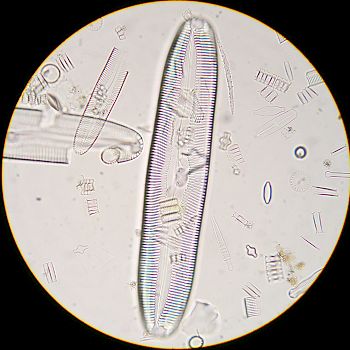 |
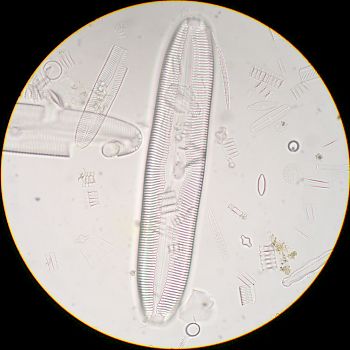 |
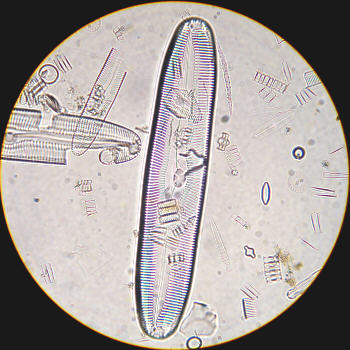 |
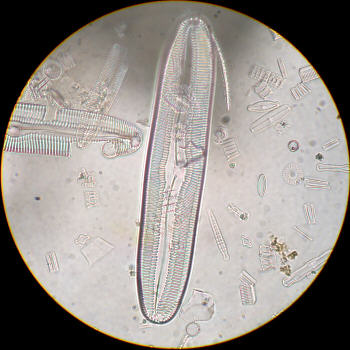 |
The conclusion I'm fairly sure you would agree, is that the imaging by this damaged Leitz objective exceeds our wildest expectations. It is important to note that the comparisons vary to a lesser degree in COL and oblique simply because the outer regions of the front optic are being utilised ; a region with rather less damage. Having said that, it should be recognised that the central zone of this objective would still scatter a large proportion of unwanted light over the image in all the illumination techniques illustrated above.
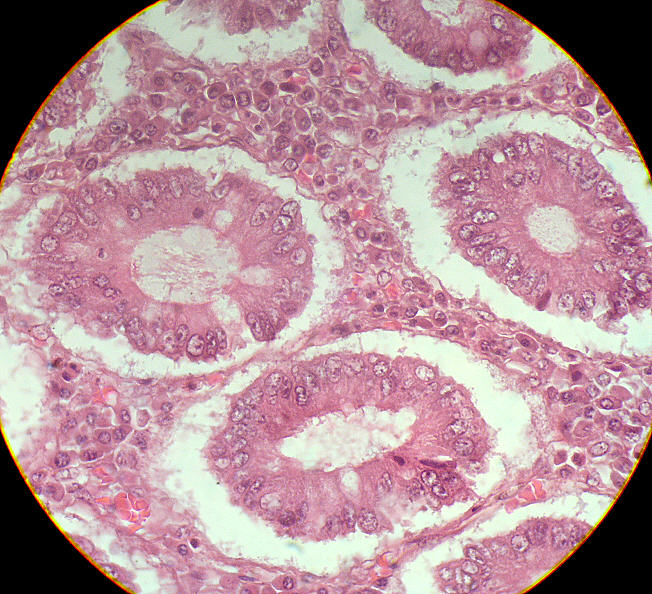 |
| Leitz's
rendering of a histological section using relatively
narrow COL annulus of 0.5-55na. and blue filter to increase contrast of the red stained specimen. Light intensity levels in software were expanded slightly yielding a reasonable image. |
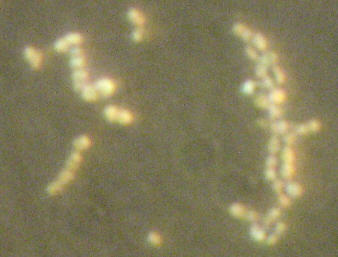 |
| Leitz's
image in DF of cultured Pneumococci. (x3500) The flare is surprisingly modest and cells fairly distinct. |
Conclusion
Even in this condition, the Leitz objective produces better imaging than some undamaged examples of objectives I have come across in the past. That such abuse should be leashed upon a beautifully designed and crafted optic from Leitz is beyond me. However the fact is that this is an example of a severely scratched object glass whose imaging should bolster anyone's confidence in buying optics that are not pristine. I can state quite confidently to those who have been unsure about the effects of markings on glass optics, especially on the front end of an objective, that a couple of linear marks or scorings have such little effect that even a trained and experienced eye would find it exceedingly difficult or more likely, impossible to detect any deterioration of the image.
The revelations of this article do not imply of course that any objective which is in perfect optical condition, will produce excellent images......that is an entirely different matter which has everything to do with the maker's skills in its design and manufacture. An exemplary optic is a gem even with minor flaws, and as shown above can still make its quality apparent even with some major damage.
Ruminating over the potential weaknesses of a 'tainted' optic might have a significant bearing on its sale value, but its imaging capabilities will probably be indistinguishable from its undamaged twin. However, there are other problems which beset objectives such as delamination, fungal growth and mechanical misalignment of the optics which are entirely different, possibly causing far worse imaging than a few surface scorings.
It seems therefore that the ubiquitous 'scratch' on the objective causes far more indents to our perception of values than to the image it was designed to project. But this is understandably a grey zone, an area which will always be riddled with debate regarding intrinsic values and the like. Nevertheless the experience of using this objective was an 'eye opener' for me, and whilst it is effectively unsaleable, it will remain in my collection of optics and no doubt will become a source of conversation in future times.
| All comments welcome by the author Paul James |
Related Micscape article: Comparing two pairs of Zeiss objectives, notes on the effect of delamination by David Walker.
Microscopy
UK Front Page
Micscape
Magazine
Article
Library
Please report any Web problems or offer general comments to the Micscape Editor.
Micscape is the on-line monthly magazine of the Microscopy
UK web
site at Microscopy-UK